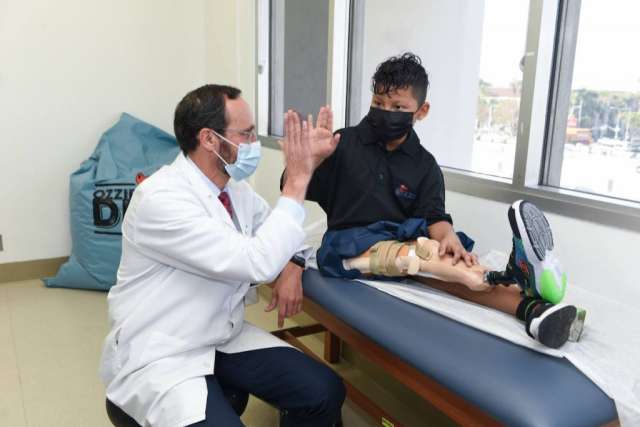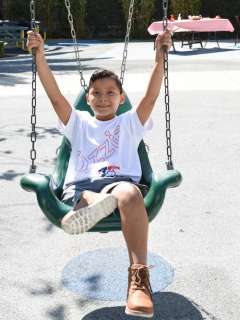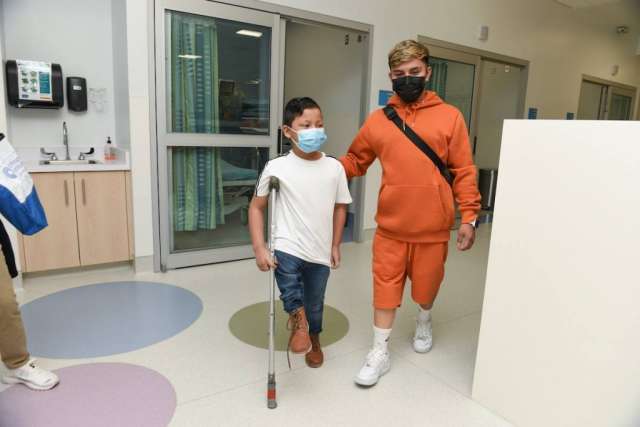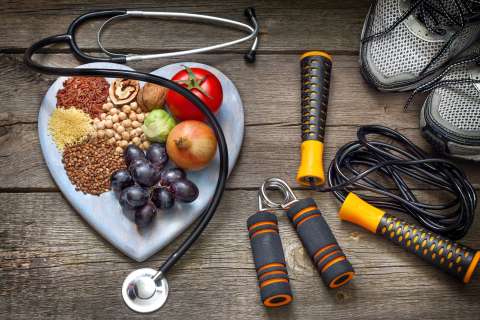Limb lengthening surgery allows child to walk on two legs for the first time
As the Los Angeles Police Department SWAT helicopter circled the Orthopaedic Institute for Children (OIC) with Santa Claus waving from on board, 10-year-old Efrain Ordoñez Jr. squeaked with excitement.
With both the OIC Toys & Joy Holiday Party and a special doctor’s appointment on Dec. 8, 2021, it was a huge day for Efrain. Not only would he get to meet Santa Claus, he would get to take home the prosthesis that would allow him to walk on two legs for the first time.
“Today’s the day, today’s the day,” Efrain told his mother Nancy, on the morning of the OIC Toys & Joy Holiday Party and doctor’s appointment.

Nancy said Efrain had trouble falling asleep the night before the appointment because he was so excited. She herself was feeling emotional.
“It’s been almost like a dream,” she said of the six-month journey since his surgery at UCLA Santa Monica Medical Center, in June, 2021.
Efrain was born with congenital femoral deficiency, part of a spectrum of conditions that affect the femur and sometimes the knee, and can cause bone deformation. In Efrain’s case, he had a severe bone deficiency in his hip and upper thigh, causing one leg to be shorter than the other.
At his birth, doctors considered him fully developed. It was just prior to his hospital discharge, however, that Efrain Ordoñez Sr. noticed his son’s right leg wasn’t moving.
“I came in to hold him as he was stretching. Then I noticed he could only move one of his legs,” Efrain Sr. recalls.
He brought it to the attention of physicians and a referral was made for the family to see a pediatric orthopaedist, who recommended a limb-lengthening procedure. Another orthopaedist for adults – a family member – intervened. He urged them not to do the procedure, citing that at a month old, Efrain was too young and the procedure would be too risky for his age.
Feeling helpless, Nancy sought the help of the Teletón Foundation, a nonprofit organization in Mexico that provides children with disabilities and cancer with comprehensive care and resources. Efrain was 3 years old when he went to his first appointment.
Physical therapists recommended he begin using crutches. Other doctors predicted Efrain Jr. wouldn’t be able to jump or run, let alone walk upright.
When he was 5, doctors from Teletón suggested above-the-knee amputation as the only viable option for fitting him with a prosthetic leg. This procedure requires two prosthetic joints and gives the patient less control over movement. The Ordoñez family hoped there might be a different option that would allow Efrain to have as much mobility as possible.
"It's really one of these amazing surgeries that kind of pushes the limit to what the human body can do.”
Dr. Nicholas Bernthal
When Nancy first moved to Los Angeles in 2018, a billboard with the words “orthopaedic” and “children” caught her attention as she and a friend were driving north on the 110 Freeway. She leaned over and said to her friend, “I’d love to be able to take my son there someday.”
Her friend assured her, “It’ll happen, Nancy.”
At an allergy appointment at the St. John’s Well and Family Clinic, the primary care doctor recognized Efrain Jr.’s leg length discrepancy and made an appointment with the Orthopaedic Institute for Children on the family’s behalf.
“I shared the address with my friend and she said to me, ‘Don’t you realize this is the exact hospital you said you wanted to bring Efrain,’” Nancy recalls, her voice breaking. “I immediately began crying, because this is where I always hoped to bring him.”
The rotationplasty procedure
In June 2021, UCLA Health surgeons Anthony Scaduto and Nicholas Bernthal performed a rare leg elongation surgery on Efrain called rotationplasty, which involves flipping the foot and leg backward and making the ankle a functioning joint.
“Van Ness Rotationplasty is one of those surgeries that doesn't make a lot of sense until you've seen one and see how well kids can do after them,” says Dr. Bernthal, interim chair and executive medical director for the department of Orthopaedics at the David Geffen School of Medicine at UCLA, adding that the surgery works well “for kids who don't have part of their leg, but have a functional foot and ankle.”
The heel, transferred from the back of the foot, becomes a knee, allowing the joint to bend.
During the rotationplasty procedure, the femoral artery and sciatic nerve are kept intact while the bottom of the leg, ankle and foot are rotated 180 degrees and reattached to the top of the leg, converting the reversed ankle joint into a functional knee joint. The foot acts as a tibia and fits into a prosthesis.
“It's really one of these amazing surgeries that kind of pushes the limit to what the human body can do,” Dr. Bernthal says. “It's spectacular in terms of results.”
Dr. Scaduto, executive vice chair of orthopaedic surgery and chief of pediatric orthopaedic surgery, says each case presents unique challenges. Efrain, for example, has well-formed bones in his foot, ankle and lower leg, but a severe deficiency in his hip and upper thigh area.
Additionally, surgeons must make precise calculations with younger patients on how much growth potential remains in the foot and ankle, so that the heel matches the level of the knee on the other side.
“For Efrain, he’s 10, so typically around the age of 16 he will become skeletally mature. We’ve calculated and accounted for about six more years of growth,” Dr. Scaduto says.

After a six-month rehabilitation, the limb lengthening surgery will allow Efrain to walk, run and jump with more mobility than above-the-knee amputation. One of the advantages to this procedure, says Dr. Scaduto, is that Efrain will have a “better shot at having better speed and control with running and playing sports.”
That’s one aspect Efrain is eager to explore. He has learned how to move around quickly with his crutch and likes to play basketball on the universally accessible playground at the OIC campus. Once he gains strength in his leg, the prosthesis will allow him to move even faster.
“Efrain has never held himself back from doing anything,” Nancy says. “He’s very motivated, independent and in school he plays soccer with his classmates. He tells them not to go easy on him either.”
On the day of his appointment, Efrain has a posse of supporters: his mom, older sister, aunt, two cousins, his care coordinator Karla Torres, his doctors, rehab team and Michael Sullivan, the vice president and chief of philanthropy. Even Ozzie, the OIC mascot, makes an appearance.
While waiting for his appointment to begin, Efrain sneaks to the basketball court with his cousins, before racing back to show off the presents Santa brought him. He’s particularly excited about the bright yellow Nerf blaster.
Dr. Scaduto says Efrain has had the perfect outlook in regard to his surgery.

“I think everyone has enjoyed his positive attitude. He has a good sense of self-awareness and he’s extremely motivated,” Dr. Scaduto says.
Other members of his care team share the same sentiment, noting how funny, eager and smart he is.
“Sometimes I think he’s smarter than me,” says Chris Caron, PT, DPT, director of rehabilitation at OIC, as she fine-tunes the fitting of his prosthesis.
Dr. Bernthal says he feels good about Efrain’s progress. He says to Efrain as he leaves the room, “I’m proud of you.”
Going the distance
Efrain and his family have come a long way – both in his medical journey and in life. The Ordoñez family, his parents and older sister, came to Los Angeles from Chiapas, Mexico, where for Efrain’s first five years, they endured countless appointments, referrals and therapies, along with little relief.
Now, months after the procedure Efrain is living out the dream she envisioned for him. Thanks to the generosity of donors and volunteers, the Ordoñez family won’t have to pay for his care.
“This is a dream,” Nancy repeats several times throughout the day. “We are grateful to all of his doctors and everyone involved. May God bless all of you.”
In many ways, Efrain’s journey resembles a patient that recently graduated from Dr. Scaduto’s care – 22-year-old José Luis Hernandez, originally from El Salvador.
Similar to the Ordoñez family, Hernandez and his family spent years searching for the right doctors and support. After meeting Dr. Scaduto, Hernandez said he finally felt at ease.
“I was afraid to have the surgery because of the way it looked,” Hernandez says of the foot being turned backward.
“It was hard for me to imagine how this complex procedure I had never seen before would lead to me living a normal life,” he says. “Dr. Scaduto showed me videos and explained the entire process to me. This made me feel more secure.”
Hernandez met Efrain during his final appointment with Dr. Scaduto. Dr. Scaduto says one of the best ways to help families overcome their concerns and fears is to introduce them to a patient that has undergone the same or similar surgery.
“For José, this was a perfect opportunity. He was right at that great age where he's had a number of years of experience with this. I think it was easy for the family to understand what was involved and get his perspective,” Dr. Scaduto says.
Hernandez has shown the Ordoñez family that it’s possible to stay independent. He drives himself to his appointments and works at Forever 21.

“When I look at Efrain, I see a younger version of myself. His situation was my own,” Hernandez says. “When I talked to him, I encouraged him to keep his confidence. I want him to become a successful person and get ahead in life.”
Like Hernandez, Efrain eagerly awaits his independence. He says when he grows up, he wants to be a mechanic for motorbikes, like his dad.
Dr. Scaduto says that will soon be a possibility.
On Sept. 28, Efrain threw out the first pitch for the Dodgers game versus the San Diego Padres. He was joined by Drs. Scaduto and Bernthal for Julio Uriás bobblehead night. On Oct. 16, he, his sister, mom and care coordinator were invited to a Los Angeles Football Club soccer match against the San Jose Earthquakes.
“He had a blast,” Torres, his coordinator, recalls. “He loves soccer.”
With strength training and consistent rehabilitation, Efrain will soon be able to play, too.
“He’s so determined,” his mom says. “I have so much hope for him.”
Learn more about the orthopaedic surgery services at UCLA Health.



